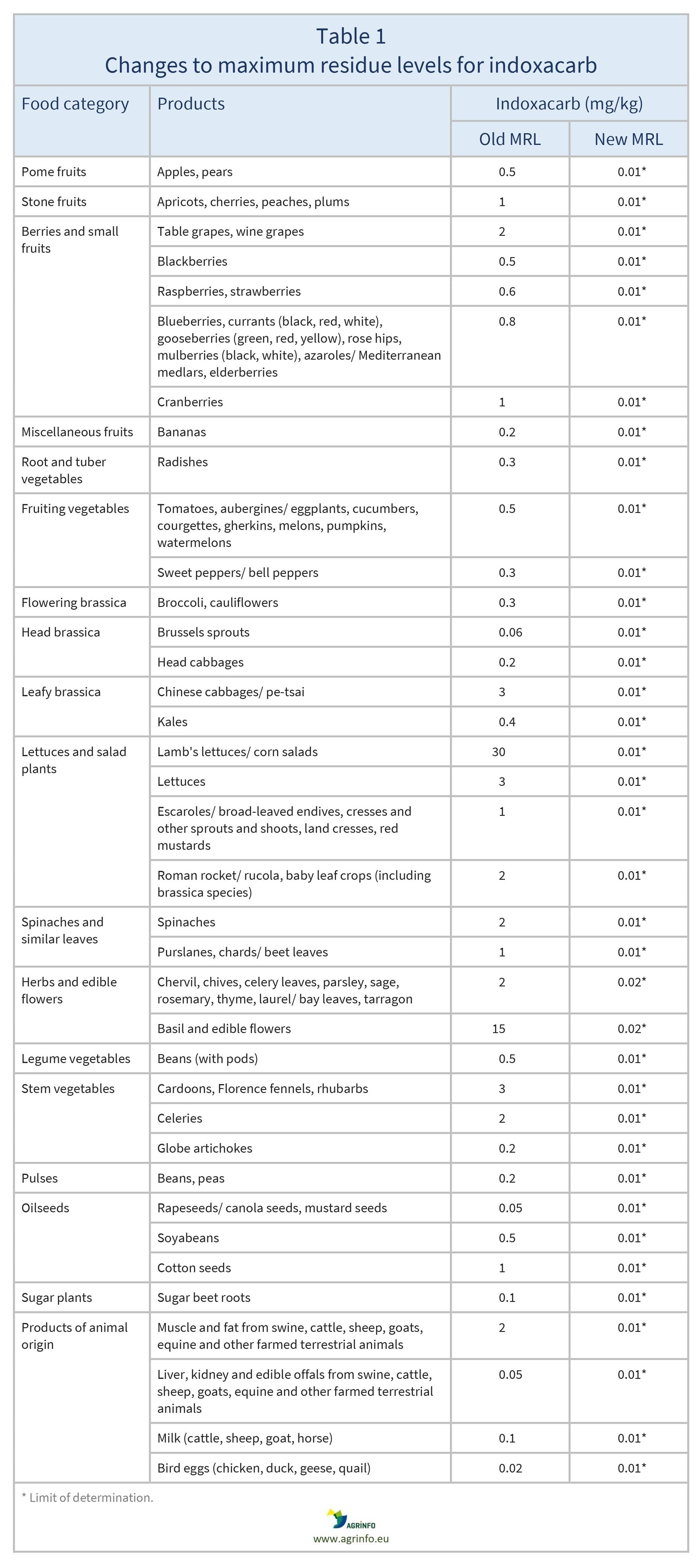Maximum residue levels for indoxacarb
- Food safety
- Pesticide MRLs
- Pesticides
Summary
The EU has reduced the maximum residue levels (MRLs) for indoxacarb to the limit of determination (LOD, the lowest level that can be detected using the most modern and reliable analytical methods). This applies to all products except cranberries and teas.
EU reduces MRLs for indoxacarb on all products
Commission Regulation (EU) 2024/376 of 24 January 2024 amending Annexes II and V to Regulation (EC) No 396/2005 of the European Parliament and of the Council as regards maximum residue levels for indoxacarb in or on certain products
Update
The EU has reduced the maximum residue levels (MRLs) for indoxacarb to the limit of determination (LOD, the lowest level that can be detected using the most modern and reliable analytical methods). This applies to all products except cranberries and teas.
Impacted Products
apples, pears, apricots, cherries, peaches, plums, table grapes, wine grapes, strawberries, blackberries, raspberries, blueberries, currants (black, red and white), gooseberries (green, red and yellow), rose hips, mulberries (black and white), azaroles/ Mediterranean medlars, elderberries, bananas, radishes, tomatoes, aubergines/ eggplants, cucumbers, courgettes, gherkins, melons, pumpkins, watermelons, sweet peppers/ bell peppers, broccoli, cauliflowers, Brussels sprouts, head cabbages, Chinese cabbages/pe-tsai, kales, lamb's lettuces/ corn salads, lettuces, escaroles/ broad-leaved endives, cresses and other sprouts and shoots, land cresses, red mustards, Roman rocket/ rucola, baby leaf crops (including brassica species), spinaches, purslanes, chards/ beet leaves, chervil, chives, celery leaves, parsley, sage, rosemary, thyme, laurel/ bay leaves, tarragon, basil and edible flowers, beans (with pods), cardoons, Florence fennels, rhubarbs, celeries, globe artichokes, beans, peas, rapeseeds/ canola seeds, mustard seeds, soya beans, cotton seeds, sugar beet roots, muscle and fat from swine, cattle, sheep, goat, equine and other farmed terrestrial animals, liver, kidney and edible offals from swine, cattle, sheep, goat, equine and other farmed terrestrial animals, milk (cattle, sheep, goat, horse), bird eggs (chicken, duck, geese, quail)
What is changing?
The EU has reduced the MRLs for indoxacarb as summarised in Table 1. MRLs remain in place for teas (5 mg/kg) and cranberries (1 mg/kg).
Why?
Since 2021, indoxacarb has not been authorised for use in the EU.
The European Food Safety Agency reviewed the renewal of this active substance (EFSA 2018), and later assessed the remaining MRLs that were based on import tolerances and Codex MRLs (CXLs) (EFSA 2022). On the basis of this assessment, the European Commission concluded that, for cranberries and teas, the current MRLs are not expected to pose an unacceptable risk for consumers, and these MRLs should be maintained.
For all other products, risks to consumer health could not be excluded. Their MRLs are therefore set to the LOD. For all products except spices and honey, the LOD has been reduced to 0.01 mg/kg. For spices and honey, the LOD remains at 0.05 mg/kg.
Timeline
The new MRLs will apply from 14 August 2024. All products on the EU market after 14 August 2024 must comply with the new MRLs, even if they were put on the market before that date. Products exported before 14 August 2024 should therefore also be checked for their compliance with the new MRLs.
Recommended Actions
Exporters of affected products should urgently review their current use of indoxacarb and evaluate possible alternative solutions to meet the new MRLs.
Background
MRLs are set in accordance with the rules set out in Regulation EC (No) 396/2005. For information on current MRLs for other substances, please consult the EU Pesticide Residues database.
Resources
EFSA (2018) Peer review of the pesticide risk assessment of the active substance indoxacarb. EFSA Journal, 16(1): 5140.
EFSA (2022) Targeted review of maximum residues levels (MRLs) for indoxacarb. EFSA Journal, 20(8): 7527.
Sources
Commission Regulation (EU) 2024/376 as regards maximum residue levels for indoxacarb in or on certain products
Tables & Figures

Source: based on Regulation 2024/376
Disclaimer: Under no circumstances shall COLEAD be liable for any loss, damage, liability or expense incurred or suffered that is claimed to have resulted from the use of information available on this website or any link to external sites. The use of the website is at the user’s sole risk and responsibility. This information platform was created and maintained with the financial support of the European Union. Its contents do not, however, reflect the views of the European Union.
EU reduces MRLs for indoxacarb on all products
Commission Regulation (EU) 2024/376 as regards maximum residue levels for indoxacarb in or on certain products
What is changing and why?
The EU has reduced the maximum residue levels (MRLs) for indoxacarb to the limit of determination (LOD, the lowest level that can be detected using the most modern and reliable analytical methods), for consumer safety reasons. This applies to all products except cranberries and teas (where the MRLs are not changed). The changes are set out in Table 1.
Actions
For all products mentioned in Table 1, suppliers should review their current use of indoxacarb and explore alternative solutions.
Timeline
The new MRLs will apply from 14 August 2024. All products on the EU market after 14 August 2024 must comply with the new MRLs, even if they were put on the market before that date. Products exported before 14 August 2024 should therefore also be checked for their compliance with the new MRLs.
Tables & Figures

Source: based on Regulation 2024/376
Disclaimer: Under no circumstances shall COLEAD be liable for any loss, damage, liability or expense incurred or suffered that is claimed to have resulted from the use of information available on this website or any link to external sites. The use of the website is at the user’s sole risk and responsibility. This information platform was created and maintained with the financial support of the European Union. Its contents do not, however, reflect the views of the European Union.
